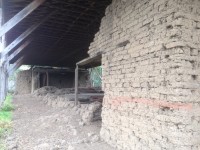Soon, school children will be visiting our mission and learning about the Native Americans who lived in the area. Fall seems to be the season for teachers to address Native cultures and November is recognized nation-wide as Native American month. Traditionally, Fall equates to harvest, and in the case of indigenous peoples, is the perfect time to collect acorns. Given that it is Fall, this week I shall touch upon the prehistoric shellmounds of the San Francisco Bay Area.
Prehistoric shellmounds have intrigued California archaeologists for over one hundred years. It was Nels Nelson, an archaeologist out of Berkeley, who set out in 1908 to document these mounds located around the San Francisco Bay. He mapped well over 400 and probably missed, for a variety of reasons, hundreds if not thousands. Nelson estimated he walked over 3,000 miles during his survey.
Shellmounds are found throughout the world, however, the sheer number and the size of those situated around the San Francisco Bay, are two features that most impress archaeologists. Shellmounds are types of midden deposits that were created inadvertently by their inhabitants via the refuge they left behind. Midden contains a variety of material such as ash, animal bone, botanical material, shell, flakes (the bi-product of tool and projectile manufacturing), artifacts, and human remains. The shellmounds surrounding the bay contain high quantities of mussel and oyster.
A number of years ago I excavated a shellmound in San Mateo that Nelson had identified in 1908, known as CA-SMA-4. Not only did he identify it, but he had a crew from Berkeley excavate a portion of the site in 1911. In reviewing his notes, he commented how for the most part, the cultural material was much the same throughout the mound. Later in his notes, he began to note differences in the types of artifacts he found at the top of the mound from those collected at the bottom.
I believe it was around this time a light bulb went on in his head. He began to understand that variation in artifact type may address cultural change through time. Subsequent excavations by Nelson, particularly in the southwest and Baja California, were conducted quite differently. Dating techniques were for the most part absent 100 years ago, however, archaeologists began to assume that many of these sites were utilized continuously for hundreds of years, and off and on for thousands. Recognizing climatic changes within the last 10,000 years, archaeologists began to link cultural change with environmental change. Nelson and others began to take a closer look at all the artifacts collected from systematically excavated sites. From around 1920 on, all archaeologists began to excavate stratigraphically, in controlled, systematic increments.
Most of these shellmounds contain human remains. It is conjectured that the native inhabitants lived on these mounds and buried their dead beneath them. As such, these are not just the habitation sites of indigenous peoples, but full -fledged cemeteries, many containing thousands of burials. Certainly digging within the soft refuse of shell and dirt would have been easier than burying a loved one in many of the hardpan soils found around the bay.
Many mounds such as the Emeryville Shellmound, was originally reported to be over 60 feet high and 350 feet in diameter. Today, very little exists. From 1870 to 1924, a large amusement park was located there which included a racetrack, two dance halls, bars, a carousel, bowling alley and shooting range. One of the dance pavilions was on top of the shell mound. From 1924 to 1999, the Emeryville Shellmound housed a large industrial site which was thought to have removed most of the mound. During the construction of a shopping mall, intact midden was identified, allowing archaeologists another opportunity to go in and try to salvage what remained of the deposit.
Some shellmounds still exist today, though development still threatens to destroy these incredible sites. Our Sonoma Bayshore also contains shellmounds identified by Nelson, though most are located on land with restricted access. To see a shellmound, a field trip to Coyote Hills Regional Park, northwest of Fremont, is in order. There, two mounds still rise high from the marshland. It was from one of these, CA-ALA-324, I conducted a human osteological study of 350 individuals buried there, in order to better understand disease through time. Other indigenous sites to see include a reconstructed tule house, shade shelter, pit house, and sweat lodge.


Be First to Comment